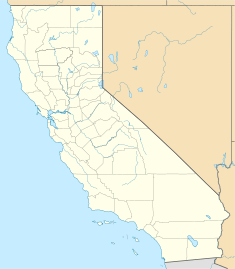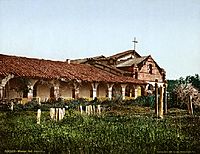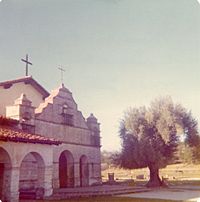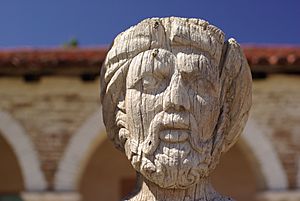Mission San Antonio de Padua facts for kids

The reconstructed Mission San Antonio de Padua as it appears today. The baked brick Campanario is unique among the Missions.
|
|
| Location | near Jolon, Monterey County, California |
|---|---|
| Coordinates | 36°00′54″N 121°15′00″W / 36.01500°N 121.25000°W |
| Name as founded | La Misión de San Antonio de Padua |
| English translation | The Mission of Saint Anthony of Padua |
| Patron | Saint Anthony of Padua |
| Nickname(s) | "Mission of the Sierras" |
| Founding date | July 14, 1771 |
| Founding priest(s) | Father Junípero Serra |
| Founding Order | Third |
| Military district | Third |
| Native tribe(s) Spanish name(s) |
Salinan |
| Native place name(s) | Telhaya |
| Baptisms | 4,419 |
| Marriages | 1,142 |
| Burials | 3,617 |
| Secularized | 1834 |
| Returned to the Church | 1862 |
| Governing body | Roman Catholic Diocese of Monterey |
| Current use | Parish Church |
| Designated | 1976 |
| Reference no. | 76000504 |
| Reference no. | 232 |
| Website | |
| http://www.missionsanantonio.net | |
Mission San Antonio de Padua is a Spanish mission established by the Franciscan order in present-day Monterey County, California, near the present-day town of Jolon. It was founded on July 14, 1771, and was the third mission founded in Alta California by Father Presidente Junípero Serra. The mission was the first use of fired tile roofing in Upper California. Today the mission is a parish church of the Diocese of Monterey and is no longer active in the mission work which it was set up to provide.
Contents
History
Beginnings of the Mission
Mission San Antonio de Padua was the third Mission to be founded in Alta California. Father Junipero Serra claimed the site on July 14, 1771, and dedicated the Mission to Saint Anthony of Padua. Saint Anthony was born in 1195 in Lisbon, Portugal and is the patron saint of the poor. Father Serra left Fathers Miguel Pieras and Buenaventura Sitjar behind to continue the building efforts, though the construction of the church proper did not actually begin until 1810. By that time, there were 178 Native Americans living at the Mission, mostly Northern Salinan (Antoniano) but also some Yokuts and Esselen.
By 1805, the number had increased to 1,300, but in 1834, after the secularization laws went into effect, the total number of Mission Indians at the Mission San Antonio was only 150. No town grew up around the Mission, as many did at other installations.
In 1845, Mexican Governor Pío Pico declared all mission buildings in Alta California for sale, but no one bid for Mission San Antonio. In 1863, after nearly 30 years, the Mission was returned to the Catholic Church. In 1894, roof tiles were salvaged from the property and installed on the Southern Pacific Railroad depot located in Burlingame, California, one of the first permanent structures constructed in the Mission Revival Style.
Restoration
The first attempt to rebuild the Mission came in 1903 when the California Historical Landmarks League began holding outings at San Antonio. "Preservation and restoration of Mission San Antonio began. The Native Sons of the Golden West supplied $1,400. Tons of debris were removed from the interior of the chapel. Breaches in the side wall were filled in." Unfortunately, the earthquake of 1906 seriously damaged the building. In 1928, Franciscan friars held services at San Antonio de Padua. It took nearly 50 years to completely restore the Mission. The State of California is requiring a $12–15 million earthquake retrofit that must be completed by 2015, or the mission will be closed. There are 35 private families keeping the mission open, as of 2011. There is an active campaign to raise funds for the retrofit.
Abandonment of Catholic missions
Despite still referred to as a mission, the Mission San Antonio de Padua is no longer active in Catholic missions and has become more focused as a parish church, fundraiser location, and tourist attraction. In 2005, the Franciscan Friars turned over the mission's caretaking and ownership to the Diocese of Monterey. Under the leadership of the Diocese of Monterey, Mission San Antonio de Padua transformed into a Catholic parish which also hosts group gatherings, gift shops and a museum with picnic grounds.
Present day
Today, the nearest city is King City, nearly 29 miles (47 km) away; Jolon, a small town, is located 6 miles (10 km) from the Mission. Historians consider the Mission's pastoral location in the valley of the San Antonio River along the Santa Lucia Mountains as an outstanding example of early mission life..
The mission is surrounded by the Fort Hunter Liggett Military Reservation, which was acquired by the U.S. Army from the Hearst family during World War II to train troops. Additional land was acquired from the Army in 1950 to increase the mission area to over 85 acres (340,000 m²). This fort is still actively training troops today.
Mission San Antonio de Padua is one of the designated tour sights of the Juan Bautista de Anza National Historic Trail.
As of 2013, Franciscan Friar Jeff Burns OFM, is in charge of the Mission.
Images for kids
-
Photograph of Mission San Antonio de Padua by landscape photographer Carleton Watkins, dating from 1873-1883.
See also
 In Spanish: Misión San Antonio de Padua para niños
In Spanish: Misión San Antonio de Padua para niños










